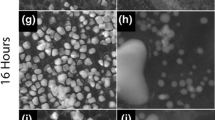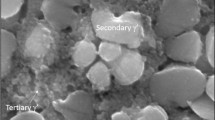Abstract
Waspaloy is a nickel base super-alloy used in aircraft engines. When this alloy is placed in service, it is subjected to long term exposure at high temperatures, which can cause the reinforcing gamma prime precipitate population to fluctuate and thus affect its structural integrity. The population fluctuates as a result of coarsening, dissolution or re-precipitation. Samples exposed to 1200° F for times ranging from 0 to 12626 hours were characterized using impedance spectroscopy, microhardness measurements, x-ray diffraction and quantitative stereology. Two important parameters were derived from the impedance measurements: (1) the imaginary admittance peak magnitude (Ymax) and (2) the associated relaxation frequency (fmax). As the distribution, shape and size of the precipitates change with exposure time, these parameters were also found to vary. In addition to the changes in precipitate geometry, lattice constant changes detected by analyzing x-ray diffraction data suggest that there are compositional shifts in the matrix as well as the gamma prime precipitates. Furthermore, the preferred orientation of the precipitates can also be seen to change with exposure time. These changes in composition, size and shape as a function of thermal exposure time are accompanied by changes in the volume fractions of primary and secondary gamma prime particles present. Using effective medium models, it is possible to predict that the measured properties are related to the gamma prime population. The grain boundary carbides do not appear to play any role at the conditions presented.
Similar content being viewed by others
References
C.T. Sims, N.S. Stoloff and W.C. Hagel, (eds), Superalloys II, John Wiley & Sons, New York, (1987).
R.A. Gerhardt, B. Lawless and D.S. Roth, “Impedance Spectroscopy of Waspaloy as a Function of Thermal Exposure to High Temperatures,” Proc. 3rd FAA/DOD/NASA Conference on Aging Aircraft, 1–13 (1999).
K. Pinkos, C. Laboy and R.A. Gerhardt, this proceedings.
ASM Handbook, vol.8 Mechanical Testing, Materials Park, OH, ASM International, 1985.
E.E. Underwood, Quantitative stereology, Addison-Wesley Publishing Company, 1981.
D.S. McLachlan, M. Blaskiewicz and R.E. Newnham, “Electrical Resistivity of Composites,” J.Am.Ceram.Soc. 84 [7], 2187–203 (1990)
Waspaloy commercial properties
Author information
Authors and Affiliations
Rights and permissions
About this article
Cite this article
Zou, X., Makram, T. & Gerhardt, R.A. Detection of Compositional Fluctuations in High Temperature Exposed Waspaloy. MRS Online Proceedings Library 699, 26 (2001). https://doi.org/10.1557/PROC-699-R2.6
Published:
DOI: https://doi.org/10.1557/PROC-699-R2.6




